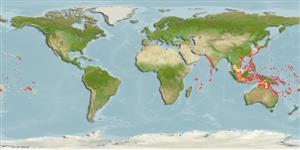Environment: milieu / climate zone / depth range / distribution range
Ecologia
marinhas associadas(os) a recifes; intervalo de profundidade 6 - 50 m (Ref. 48637), usually 6 - 15 m (Ref. 27115). Tropical; 22°C - 27°C (Ref. 27115); 36°N - 38°S, 53°E - 133°W
Indo-Pacific: Seychelles and Chagos Islands to the western Pacific.
Tamanho / Peso / Idade
Maturity: Lm ? range ? - ? cm
Max length : 12.0 cm SL macho/indeterminado; (Ref. 48637)
Espinhos dorsais (total): 7; Raios dorsais (total): 35-39; Espinhos anais 1; Raios anais : 33 - 37; Vértebras: 26. Pale blue to yellowish; upper abdomen with a broad area of deeper blue; a bar, broad and blackish extending ventrally from eye onto chin; iris yellow, upper and lower edges broadly deep blue; postorbital head with irregular, iridescent markings. A single, continuous dorsal fin with spinous part lower than soft portion. Chin with fleshy protuberance narrowing to a thin low, median fold. Scales very small, fully embedded and well separated. Named as such in reference to its continuous dorsal fin.
Lives in reef habitats from shallow coastal slopes to outer reef lagoons and slopes below drop-offs to 50 meters, among rubble (Ref. 48637). Occurs in pairs and its burrow may be in coral rock or sand. Monogamous (Ref. 52884). Feeds on zooplanktons (Ref. 89972). They tend to form large, though diffuse, colonies; may be due to a propensity to aggregate or may be a result of the ecological requirements for the species (for which type of substratum, current pattern, and water depth among the most important) which restrict the areas of settlement of the postlarvae.
Ciclo de vida ou comportamento de acasalamento
Maturidade | Reprodução | Desova | Ovos | Fecundidade | Larvas
Monogamous mating is observed as both obligate and social (Ref. 52884).
Randall, J.E. and D.F. Hoese, 1985. Revision of the Indo-Pacific dartfishes, genus Ptereleotris (Perciformes: Gobioidei). Indo-Pac. Fish. (7):36 p. (Ref. 528)
Status na Lista Vermelha da UICN (Ref. 130435)
Ameaça para os humanos
Harmless
Uso pelos humanos
Aquário: Espécies comerciais
Mais informação
ReferênciasAquaculturaPerfil para aquaculturaEstirpesGenéticaElectrophoresesHereditariedadeDoençasProcessamentoNutrientsConversão de massa
ColaboradoresFotosStamps, Coins Misc.SonsCiguateraVelocidadeTipo de nataçãoÁrea branquialOtólitosCérebrosVisão
Ferramentas
Relatórios especiais
Baixar XML
Fontes da internet
Estimates based on models
Preferred temperature (Ref.
123201): 23.3 - 29.1, mean 28 °C (based on 2128 cells).
Índice de diversidade filogenética (Ref.
82804): PD
50 = 0.5000 [Uniqueness, from 0.5 = low to 2.0 = high].
Bayesian length-weight: a=0.00389 (0.00180 - 0.00842), b=3.12 (2.94 - 3.30), in cm total length, based on all LWR estimates for this body shape (Ref.
93245).
Nível Trófico (Ref.
69278): 3.4 ±0.45 se; based on food items.
Fishing Vulnerability (Ref.
59153): Low vulnerability (10 of 100).
Nutrients (Ref.
124155): Calcium = 111 [58, 188] mg/100g; Iron = 0.815 [0.492, 1.362] mg/100g; Protein = 18.1 [17.0, 19.1] %; Omega3 = 0.0997 [, ] g/100g; Selenium = 30.1 [14.2, 63.2] μg/100g; VitaminA = 208 [72, 629] μg/100g; Zinc = 1.84 [1.23, 2.60] mg/100g (wet weight);
